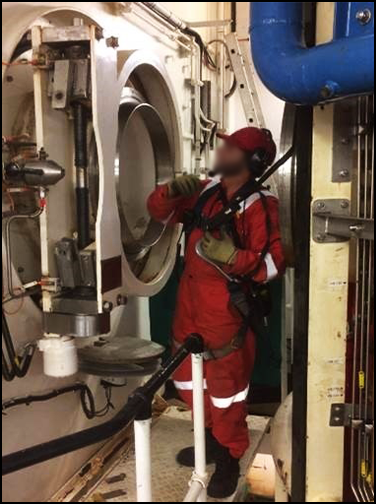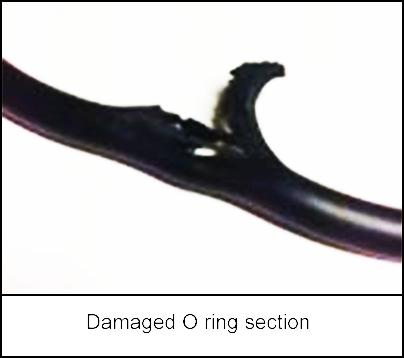-
What happened?
A diving bell was being locked on to the saturation system on a diving support vessel (DSV).
The team had difficulty closing the locking clamp.
After a few attempts, the clamp was successfully closed and the interlock pin was inserted.
A leak was detected during pressurisation of the trunking.
The pressurisation was stopped, and the clamp opened for further inspection.
A damaged O ring was discovered and changed out.
The bell was then successfully mated, and the divers transferred to the living chambers.
The incident had high potential for fatality had the leak not been discovered.

-
Why did it happen?
The O ring had become displaced before the bell mating, and a section of the O ring had come out of its groove.
When the bell was mated, the O ring prevented the two faces from coming into correct alignment.
During repeated clamp closures, the O ring was damaged and pushed back into the groove until the clamp closed fully and the interlock engaged.
The misplacement was not identified as the O ring seal had not been fully inspected (by sight or touch) before the bell lock off and reconnection.
- Full inspection required working at height equipment and was only carried out on a scheduled basis (not every bell run).
The pressurisation procedure proved there was a leak past the O ring.

-
What did they learn?
Bell mating flanges and seals should be inspected between every bell run to ensure they are in correct location and in good condition.
Improve access for carrying out this task without the need for specialist work methods and associated personal protective equipment (PPE).

-
Ask yourself or your crew
How often are clamps and seals inspected on your diving bells?
How are they inspected?
Do you require any specialist PPE to carry out inspections?
Is there an easier and safer way in which inspections could be completed?
What is your reporting procedure if you notice a problem on site?

Add to homescreen
Content name
Select existing category:
Content name
New collection
Edit collection
What happened?
A diving bell was being locked on to the saturation system on a diving support vessel (DSV).
The team had difficulty closing the locking clamp.
After a few attempts, the clamp was successfully closed and the interlock pin was inserted.
A leak was detected during pressurisation of the trunking.
The pressurisation was stopped, and the clamp opened for further inspection.
A damaged O ring was discovered and changed out.
The bell was then successfully mated, and the divers transferred to the living chambers.
The incident had high potential for fatality had the leak not been discovered.

Why did it happen?
The O ring had become displaced before the bell mating, and a section of the O ring had come out of its groove.
When the bell was mated, the O ring prevented the two faces from coming into correct alignment.
During repeated clamp closures, the O ring was damaged and pushed back into the groove until the clamp closed fully and the interlock engaged.
The misplacement was not identified as the O ring seal had not been fully inspected (by sight or touch) before the bell lock off and reconnection.
- Full inspection required working at height equipment and was only carried out on a scheduled basis (not every bell run).
The pressurisation procedure proved there was a leak past the O ring.

What did they learn?
Bell mating flanges and seals should be inspected between every bell run to ensure they are in correct location and in good condition.
Improve access for carrying out this task without the need for specialist work methods and associated personal protective equipment (PPE).
Ask yourself or your crew
How often are clamps and seals inspected on your diving bells?
How are they inspected?
Do you require any specialist PPE to carry out inspections?
Is there an easier and safer way in which inspections could be completed?
What is your reporting procedure if you notice a problem on site?
A diving bell was being pressurised when a leak was detected. A damaged O ring was discovered and changed out.













